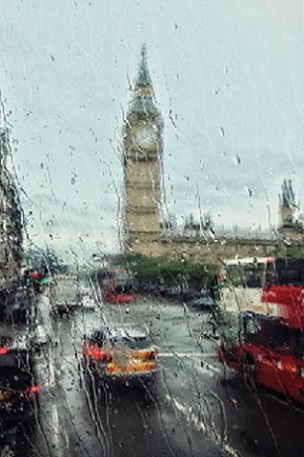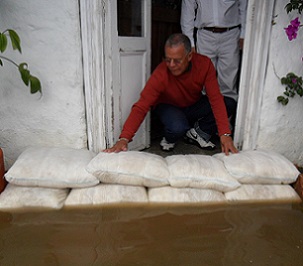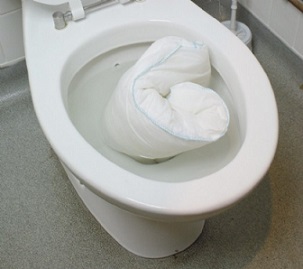 London can get hit by torrential rain in summer. Photo by Sid Ali from free photo website Pexels.
London can get hit by torrential rain in summer. Photo by Sid Ali from free photo website Pexels.
 FloodSax alternative sandbags keeping filthy floodwater out of a home
FloodSax alternative sandbags keeping filthy floodwater out of a home
 Just one FloodSax popped down a toilet can prevent filthy floodwater backing up from the sewers
Just one FloodSax popped down a toilet can prevent filthy floodwater backing up from the sewers
 Richard Bailey, managing director at Environmental Defence Systems Ltd
Richard Bailey, managing director at Environmental Defence Systems Ltd
The London floods of July 2021 were probably even more damaging than first thought … and fears are growing there are more devastating floods to come for the UK’s capital city
London remains incredibly vulnerable to flash flooding after devastating floods last summer damaged hundreds of homes and the underground network causing millions of pounds of damage.
Now a hard-hitting report has revealed this could easily happen again as there is an absence of systems and leadership to deal with a similar severe weather.
Many Londoners don’t realise councils have absolutely no responsibility to provide sandbags or other flood mitigation products.
London was hit by severe flash flooding twice last July when intense rainfall overwhelmed the capital’s drainage systems, flooding roads, Tube stations, hospitals and more than 1,000 homes.
A report by the London Councils’ Surface Water Flooding Task and Finish Group has revealed: “More than 1,000 properties were reported as flooded although there is suspected to be significant under-reporting. Surface water flooding poses a growing and significant risk to Londoners but is still poorly understood and under-resourced. Our work has underlined profound weaknesses with the current approach.”
In all, 24 London boroughs were badly impacted by flooding and in some areas twice the average monthly rainfall for July fell in a few hours.
Why couldn’t London cope with the flash floods of July 2021?
According to the London Councils report, London faces several types of flood risk – tidal flooding, fluvial (river) flooding, surface water (pluvial flooding), sewer and groundwater flooding.
Surface water flooding happens when the drainage system becomes overwhelmed and simply can’t cope with the amount of water falling from the sky with rain being unable to get into drains, sewers or watercourses.
Here are the reasons why London suffered so badly from flooding.
- A Victorian drainage system that’s simply outdated and not fit for purpose for a large modern city with a growing population.
- Gardens replaced with impermeable surfaces such as concrete and tarmac so the water has nowhere to soak. This is known as urban creep and read more about that here.
- Public’s lack of awareness that they are at such high risk of flooding, what they can do to mitigate the ever-present flood threat and what to do if flooding happens.
- The worrying fact that this can happen again at any time due to the ever-growing consequences of climate change.
The report warns: “The severity of this issue is likely to increase over the coming decades due to expectations that climate change will lead to more frequent, intense storms.”
Richard Bailey, managing director of flood prevention company Environmental Defence Systems Ltd, said: “The problem is people assume their local councils will come running with sandbags if flooding is imminent and this is simply not the case. People, especially those in areas at high risk of flooding such as London, need to organise their own flood prevention and flood mitigation measures.
“It’s really worrying that so many people only think about flood prevention when it’s too late and they’ve already been flooded and suffered the trauma, misery and huge financial cost all that entails.
“As we sadly saw last summer, surface water flooding is a huge threat to Londoners – especially those who live in ground-floor or basement dwellings – as the water often has nowhere to go except into their homes.”
Environmental Defence Systems Ltd sells its award-winning FloodSax alternative sandbag worldwide.
Richard added: “We’ve sold 3 million FloodSax worldwide since 2007 and that’s because they are so space-saving to store yet quick and easy to deploy in a flooding emergency so people have flood protection and peace of mind 24/7 and 365 days a year. Now is the time to stock up on anti-flood devices while the weather is calm and dry.”
The most horrendous aspect of the July 2021 London floods was that the sewers couldn’t cope with all the water pouring into them so they back up, sending filthy, contaminated sewage floodwater back up the toilets, flooding flats. A FloodSax sandless sandbag costing just a few pounds jammed down the toilet would have prevented that.
Richard added: “The risk will always be there but has to be managed which is why people really do need to think about their own flood protection.”
The London Councils Taskforce discovered several major problems which explain why the city was so unprepared for the July 2021 London floods.
- No single organisation is in overall charge of managing surface water flood risk in London.
- There is a lack of money to manage the risk and insufficient knowledge about potential funding opportunities.
- There is a lack of understanding of what flood assets are currently available, who owns and maintains them and what condition they are in.
- There is a lack of modelling that can help organisations understand where floods are most likely to happen and what should be done to lower the risk.
- There is a lack of understanding about the risks of surface water flooding and who is responsible for reducing these risks.
- There is no overall strategic plan and vision and no organisation to develop and implement it.
A strategy has now been recommended to tackle all these problems.
For more information on FloodSax alternative sand bags please go to http://www.floodsax.co.uk/